The dawn of ai in viticulture: from precision to prediction
Leveraging technology: the changing face of grape growing
2023-06-29

In an era where technology is rapidly evolving, the adoption of Artificial Intelligence (AI) is reshaping various sectors, with viticulture being no exception. As advanced technologies like AI have become more accessible, grape growers are beginning to experience a paradigm shift in vineyard management.
From ChatGPT making headlines almost daily, to precision agriculture software, and drones equipped with sensors that monitor vine health, AI's influence is increasingly palpable. Moreover, the integration of autonomous robots and tractors into vineyard operations marks a significant leap in the industry's evolution.
Adopting new technologies is not without its challenges. From trust issues to the financial implications of replacing existing systems, there are hurdles to be overcome. However, a recent meta-analysis conducted on innovation within the wine industry revealed a positive correlation between financial performance and the adoption of new technologies.
Adopting AI: a practical approach to innovation
The Wine Industry Sales Symposium recently featured Justin Noland, head of DTC at Treasury Wine Estates and a successful adopter of AI. He recommended a practical approach to AI adoption, suggesting that the first step is to delegate tasks to free up time.
Noland advocates for a hands-on approach, stating, "There's no substitute for just doing it." As AI systems learn from user feedback, the more feedback you provide, the better the system becomes.
Robots and Drones: the future of viticulture
Mechanization is increasingly vital to the over 600,000-acre wine grape industry in California, particularly as farmers seek solutions to labor shortages and climate change impacts. The shift towards mechanization began with the mainstream use of machine harvesting. Today, growers are exploring the use of remote-control and autonomous tractors and robots for tasks like weed control, soil amendments, and pruning.
One often overlooked but substantial advantage of using autonomous machines is their ability to capture sensor readings and images while performing repetitive tasks. This functionality significantly increases the data volume fed into AI systems, dramatically expanding the knowledge base for machine learning analysis, leading to more accurate recommendations.
Machine Learning: the power of pattern recognition
Machine learning, a subset of AI, uses large volumes of historical data and algorithms to recognize patterns and make decisions based on current data. In vineyards, autonomous tractors and robots use data collected by mounted sensors to navigate. These "perception stacks" identify obstacles, recognize vines that need trimming, and differentiate weeds from trunks.
Machine learning can also analyze data from drones, satellites, weather stations, and soil sensors to build irrigation schedules, identify diseases, or monitor ash particles in the air. Deep learning, an aspect of machine learning that uses neural networks, can handle more complex patterns, such as identifying "drivable" space for autonomous vehicles.
Predictive Analytics: the crystal ball of viticulture
Predictive analytics, another promising frontier of AI, enables grape growers to manage complex ecosystems more efficiently. These AI models can predict issues such as pest infestation and water stress, and propose corrective actions. Sensors update these models in real-time, making predictions about every vineyard block and automatically revising irrigation and spraying schedules.
Predictive analytics can also estimate harvest yields and grape quality, forecast extreme weather, predict pest and disease outbreaks, and measure a winery's progress on greenhouse gasses and soil carbon respiration and sequestration.
Embracing the AI Revolution: navigating the path forward
While some grape growers are captivated by the potential of AI and are experimenting with different solutions, many find themselves overwhelmed. Uncertainty persists regarding the solutions that provide the most value in terms of time and investment. Nevertheless, the viticulture landscape is evolving rapidly, making it crucial to explore the transformative capabilities of AI for grape growers and their prized vineyards.
Founded in 2007, Vinetur® is a registered trademark of VGSC S.L. with a long history in the wine industry.
VGSC, S.L. with VAT number B70255591 is a spanish company legally registered in the Commercial Register of the city of Santiago de Compostela, with registration number: Bulletin 181, Reference 356049 in Volume 13, Page 107, Section 6, Sheet 45028, Entry 2.
Email: [email protected]
Headquarters and offices located in Vilagarcia de Arousa, Spain.